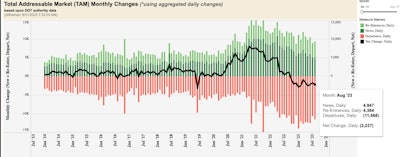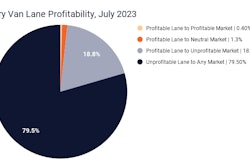Saudi Arabia and Russia this month each elected to extend cuts in production of heavy crude oil through the rest of the year, just as U.S. seasonal demand begins to trend up. Heavy crude oil is the base for both heating oil and diesel fuel, and through the winter months refineries have to balance production of the two distillates with, generally, whichever is priced higher winning the lion's share of production.
A lack of the preferred heavy crude means refineries are working harder and processing more volume, but with less yield.
"We are running about 700,000 barrels per day more crude than we were on this day a year ago," said Tom Kloza, chief oil analyst and global head of energy analysis at Oil Price Information Service (OPIS), "but we're running almost exclusively light sweet crude, which has a low diesel yield, and we're making about 10,000 less [barrels] distillate each day. That presents a problem for now through November."
Kloza said the likelihood that the U.S. will build distillate inventories to a comfortable level by Thanksgiving "is very low," yet despite this risk few traders are willing to stock up on diesel and heating oil ahead of the winter, he added.
"There is too much backwardation in the price. Price is much lower 60-90 days out. That structure doesn't favor inventory accumulation and it sets up a repeat of last year where inventories are dangerously low coming into winter," Kloza said.
Distillate inventories last year hit their lowest level since 2008, according to the Energy Information Administration (EIA), just as diesel prices crested back over $5 per gallon. In October, distillate levels reached a low-point not seen in that month since 1982, however, a widespread shortage at the fuel island didn't materialize. The level of U.S. distillate fuel oil stock has been building since early August and is currently about 122 million barrels, about 15 million more than what was available in the trough of October 2022 before rebounding to almost 120 million to end last year.
Will there be a diesel fuel shortage?
Diesel inventories are low, according to David Fialkov, executive vice president of government affairs for both NATSO and SIGMA, the trade organizations for fuel marketers and truck stops, but "the market is adjusting to get product where it needs to be as efficiently as possible. The low inventory levels leave us exposed to sudden increases in demand or decreases in supply," he added. "For example, if a major refinery shuts down for a period of time, the cause for concern could increase.”
A spokesperson for Love's Travel Stops told CCJ Wednesday the company sees "a potentially tight market if we have a really cold winter, but Love’s will continue to leverage (Love's subsidiaries and fuel haulers) Musket and Gemini to keep locations stocked as best as possible."
Pilot Company Vice President of Supply and Distribution Ted Brennan said Pilot feels confident "that we will be able to maintain supply to our stores despite low distillate inventory levels," adding Pilot Company has a resilient supply chain with diverse capabilities "including global fuel sourcing and a vast trucking fleet that enable us to adapt and remain a reliable source of fuel. We are aware that domestic and global diesel inventory levels are lower than average due to a variety of factors and anticipate the U.S. distillate market could potentially see further tightening from September through November. Pilot Company is prepared to mobilize our resources accordingly to maintain a steady supply of fuel for our customers and guests.”
TravelCenters of America declined to comment for this story.
If there is a big fluctuation in diesel prices Kloza said it may take place between Thanksgiving and Valentine's Day. If winter is cold, a lot of diesel molecules will go to the heating oil market. If it's really cold, Kloza said, some utilities might turn to diesel for peak shaving needed for maximum power.
Diesel currently fetches "an epic premium," Kloza said, of $50.67/bbl over WTI crude, so some of the bullish sentiment is baked in. If the winter is cold, Kloza said diesel could fetch $50-$100/bbl over the price of crude. "So don't be lulled by the diesel cha-cha in the next 60 days," he said. "It could set it up for a violent move come late November. The mismatch of crude for refiners (too much super-light, gasoline-rich crude) suggests lower prices for gasoline but higher prices for diesel."
Implications for capacity contraction
 This chart shows the net change between carriers coming and going based on new and reactivated motor carrier authorities and revocations (the black line is the spread). These are just long-haul interstate carriers, with the exception the addition of California, Florida and Texas intrastate carriers due to the long-haul nature of freight moved within each state.Dean Croke
This chart shows the net change between carriers coming and going based on new and reactivated motor carrier authorities and revocations (the black line is the spread). These are just long-haul interstate carriers, with the exception the addition of California, Florida and Texas intrastate carriers due to the long-haul nature of freight moved within each state.Dean Croke
Diesel prices across the U.S. have climbed 10 of the last 11 weeks, jumping more than 86 cents since the week ending July 10. The national average for a gallon of on-highway diesel is $4.63 – the highest weekly average this year, and the highest pump price since mid-December 2022.
There’s a rule of thumb that operating costs increase 1-cent per mile for every 10-cent increase in the retail price of fuel. By this estimate, operating costs are up about 8 cents per mile since July 4. Over that same timeframe, linehaul rates are down about 8 cents per mile, according to DAT – a total swing of 16 cents per mile sapped from motor carriers' bottom line.
Today's total breakeven operating costs are around $1.90 per mile, said DAT Freight & Analytics Principal Analyst Dean Croke. "We're back into 2019 levels of unprofitability, losing 9 cents per mile with all-in dry van rates at $2.06 per mile and fuel at $4.63 per gallon," he added.
Diesel's per-gallon average retail crossed the $5 mark nationwide for the first time ever in March 2022 and remained north of there for seven of the next eight months. It's not been back in that range on a monthly basis since last December, but Kloza said it's realistic that $5 per gallon at the diesel pump is back in play regionally for periods of time.
"I think a normal winter of temperatures in the Northern Hemisphere would see many U.S. states with diesel prices above $5 per gallon," he said. "When it comes to price action, 'winter' can often be the stretch of days from Thanksgiving through Valentine's Day. Colder than normal temperatures might bring about considerably higher numbers, particularly for coastal states."
An ongoing spike in diesel prices is likely to be the tipping point in a trucking capacity rebalancing. Low rates have forced many motor carriers to dig into cash reserves banked from 2021 and 2022. Many are likely down to the last bits of that war chest with rising costs of repairs, labor and, now, fuel, colliding with sagging rates and low volume.
"If the diesel run-up continues – and that certainly seems a reasonable assumption given the steady increase in crude prices recently – we would expect carrier exits to accelerate unless we see stronger spot rates than we are seeing, or expect to see, in the near term," said FTR Vice President of Trucking Avery Vise. "In addition to the cash flow issue, many small operations face one of two challenging scenarios. Many probably are still running trucks bought before the pandemic or early in the pandemic, and mostly bought used then, and now need to replace those trucks at higher financing costs. Others purchased used trucks at inflated prices in 2021 or 2022, which might put many of them underwater given current rates, volume and fuel prices."
Higher diesel prices put the greatest stress on operators that achieve poor miles per gallon, have a lot of deadhead mileage and don't properly factor higher fuel costs in spot bids. For carriers that operate at a high MPG, especially above the fuel peg used to set surcharges, higher diesel prices can actually be profitable, especially in LTL.
[Related: Methods of measuring fuel economy]
"So far, capacity has been quite slow to exit the market, likely because we saw diesel prices come down in 2023 until recently," said Jason Miller, supply chain professor at the Eli Broad College of Business at Michigan State and veteran transportation economist. "As such, if we start to see sustained increases in diesel prices, I expect the more inefficient operators with high deadhead, low MPG, and not properly factoring in fuel costs into spot rate bids to be the most likely to fail."
FTR's near-term freight demand forecast is stable, yet Vise noted there are "significant" risks to the firm's outlook. Consumer spending on goods has remained strong, but steady consumption is a risk as the labor market cools and many college graduates face the resumption of student loan repayments this fall.
"The number of active for-hire carriers has declined in all but one month since last October. That is by far the longest period of net decreases since the Great Recession, which saw the carrier population fall for 15 straight months at one point and a decrease in 28 of 30 months," Vise said. "If carrier failures accelerate due to escalating diesel prices, we might not see the results in the data for another month or two. The revocations data inherently lags market conditions by a couple of months or more because carriers have 30 days to replace lapsed insurance policies."
Looking back to when Russia invaded Ukraine in late February 2022 causing diesel prices to spike, there was a surge in motor carrier authority revocations, then another surge of exits around the time diesel hit $5.80 gallon last summer before net capacity exited the market in October 2022.
"We've been leaking capacity slowly since then," Croke said, "but only because diesel had been dropping steadily during the first half of this year, allowing carriers to hang in – barely," Croke said. "When diesel took off again in July, it sent another round of carriers out of the industry in August, suggesting more exits are to come as the cash flow crunch bites. Spot rates bottoming out for the last six weeks and lackluster demand aren't helping carriers either."













